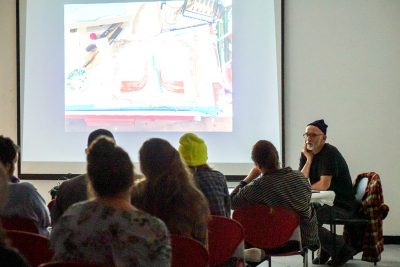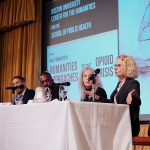
With strokes of a paintbrush, artist Frank Jackson creates an intricate landscape of intertwining geometric red and pink shapes and lines. Tuesday evening, the New England-based artist displayed his stylistic journey through a slideshow of some of his pieces at Boston University’s 808 Gallery.
BU’s Painting and Sculpture graduate programs have invited a new artist every Tuesday night to to lecture and share their artwork with those who attend. The “Tuesday Night MFA Lecture” series exposes graduate students and other audience members to contemporary artists and their work.
Over the years, he explained his use of materials and spectrum of approaches has become gradually more experimental, though his color palette comprised of reds, pinks and whites has remained consistent. Regardless of the medium, Jackson said he has focused on transforming familiar landscapes, events and feelings into fiction throughout his career.
“It is important that there is not one matrix [of art] that everyone has to be a part of,” Jackson said in an interview. “There are as many variations as there are individuals, and that is something to be embraced.”
Josephine Halvorson, professor of art and chair for Graduate Studies in Painting at BU, creates the curriculum of the graduate painting program and is largely responsible for organizing these visiting artist lectures. She said she requires all 22 of her students to attend each Tuesday night lecture, though she believes they want to come naturally.
“It is a rare opportunity to have so many artists with such diverse practices come to speak to them,” Halvorson said. “What I try to bring here in the context of a painting program is a range of totally different approaches to painting, so students can realize that there is a variety [of approaches].”
Jackson began his lecture after an introduction from one of the graduate painting students with images of his paintings from 30 years ago. As he progressed through his personal timeline, he explained his expanded acceptance of new materials.
One of his newer pieces, for example, used watercolor, gouache, acrylic, enamel, pigment and dirt in the final production. Furthermore, in a study completed five years ago, Jackson said he experimented with drizzling latex paint over patches of snow and took pictures as it melted and changed.
As students and Halvorson interjected with questions, the lecture evolved into more of a discussion.
“The lecture was fantastic,” said Alex Stern, a graduate painting candidate. “[Jackson] spoke directly and honestly and really gave us the reality of his practice, which I related to strongly.”
Once Jackson reached the subject of his most recent projects, a series of small frescoes and images of water, he allowed time for questions. Halvorson commented on how Jackson’s approaches may be interpreted by outsiders as abstract, though she did not hear the artist describe his work as “abstraction.”
In response, Jackson explained that he struggles with the terms assigned to different types of artists and enjoys pushing himself out of his comfort zone while maintaining a personal connection to his work.
“[Jackson] alluded to his interests in such a wide variety of things, all of which have the equal opportunity to bring him a sort of ecstasy and a real joy,” Stern said. “I think it is important for an artist to allow themselves to be open-minded and open-hearted to a lot of life.”
Halvorson said she was impressed with the engagement and participation of her students, but did share that she wouldn’t mind expanding the audiences at the lectures.
“I would love to see more undergraduate students who study visual art,” Halvorson said. “I would [also] love to see more administration come [because] I think in any graduate degree or any graduate program that is so deep into what they do, it is hard to translate [art] outwards to a broader audience.”
Jackson’s lecture provided the attending graduate students with knowledge and inspiration for their own practices. The artist also explained how he copes when he occasionally loses his stylistic curiosity.
“Sometimes I am not inspired and I do not think that it is necessarily limited to an artist,” Jackson said. “Sometimes I feel productive in getting things done, and other times I feel like I am banging my head against the wall and nothing is really working. Trying to figure out why it is not working is important.”


